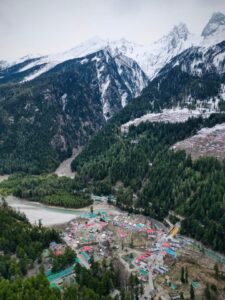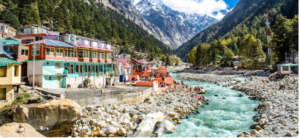Nestled in the towering heights of the Himalayas, the Gangotri Temple is one of the holiest shrines in Hinduism. Located in the Uttarkashi district of Uttarakhand, India, this sacred site draws thousands of pilgrims each year who come to worship the goddess Ganga, personified as the river Ganges. However, beyond its religious significance, the Gangotri Temple carries an aura of mystery, with legends, natural wonders, and untold stories that intertwine spirituality with intrigue.
This temple is a part of the Chota Char Dham pilgrimage, a group of four temples that are considered highly auspicious in Hindu tradition. Yet, Gangotri stands apart not only because of its spiritual stature but also due to the myths and mysteries surrounding it. These mysteries range from ancient tales, geographic oddities, and miraculous events that have baffled both believers and skeptics for centuries.

The Origins: A Mythological Perspective
The legend of the Ganges River’s descent to Earth is one of the most famous stories in Indian mythology and is intrinsically linked to the Gangotri Temple. According to Hindu beliefs, King Bhagirath performed severe penance to bring the celestial river Ganga to Earth in order to cleanse the souls of his ancestors who had been cursed by Sage Kapila. Pleased with his devotion, the goddess Ganga descended from the heavens.
However, the force of her descent was so powerful that it threatened to destroy the Earth. In response to this dilemma, Lord Shiva intervened by capturing the river in his matted hair and gently releasing it from a lock, allowing the waters to flow with controlled force. It is believed that this event took place at Gangotri, where the temple now stands.
However, the mysteries around Gangotri are not limited to its mythology. The physical temple itself and the surrounding area have their own share of intriguing elements that spark curiosity and wonder.
The Ancient Temple and Its Ever-Changing Structure
One of the most fascinating aspects of Gangotri Temple is its architecture and location. The current temple structure was built by Amar Singh Thapa, a Gorkha general, in the early 18th century. Made of white granite, it exudes an ethereal beauty. However, what baffles many is how this ancient temple has withstood the test of time despite being located in a region prone to natural calamities such as landslides, floods, and earthquakes. The resilience of the temple amidst the harsh, shifting environment of the Himalayas is seen by many as an unsolved enigma.
Furthermore, there are tales of the temple’s location shifting over time. Some locals and historians claim that the original Gangotri Temple was not in the present location but further up the mountains, closer to the actual source of the river. Whether this shift was due to geological factors or human intervention remains a topic of debate. Still, it adds a layer of mystery to the temple’s existence.

The Disappearing River Source: Gaumukh Glacier
Gangotri Temple is not only a place of worship but also marks the origin point of the Ganges River. The actual source of the river is a glacier known as Gaumukh, located about 19 kilometers from the temple. Pilgrims often trek to Gaumukh to witness the origin of the holy river. However, in recent decades, an alarming phenomenon has been observed: the glacier is receding at an unprecedented rate. This has raised questions among both scientists and spiritualists.
Some attribute the shrinking glacier to climate change, while others, especially in religious circles, see it as a sign of divine displeasure or the approach of the end times, as mentioned in Hindu eschatology. Whatever the reason, the mysterious recession of the Gaumukh glacier adds an eerie and urgent quality to the temple’s already sacred reputation.
The Miracles and Unexplained Events
Gangotri Temple is also famous for the stories of miracles that surround it. Devotees often recount tales of supernatural occurrences, such as sudden changes in weather, where the skies clear up miraculously for prayer or special ceremonies, only to be followed by intense rain or snowfall right after the rituals are completed. Some visitors even claim to have witnessed the sacred waters of the Ganges glowing during nighttime, although there is no scientific explanation for this phenomenon.

Furthermore, there are numerous accounts of pilgrims experiencing divine visions or hearing mysterious, ethereal sounds while meditating in the vicinity of the temple. Although these experiences are deeply personal, they have contributed to the collective mystique surrounding Gangotri, drawing in spiritual seekers from all walks of life.
The Seasonal Mystery: Why the Temple Closes in Winter
One of the most unusual aspects of Gangotri Temple is its seasonal closing. Each year, the temple is closed during the winter months due to heavy snowfall and inhospitable conditions. During this time, the idol of the goddess Ganga is moved to a nearby village called Mukhba, where worship continues until the temple reopens in spring. However, locals believe that during the time the temple is closed, the gods themselves visit the site to perform their own rituals in the absence of human interference.
There is a deeply held belief that during the winter months, divine beings walk the deserted snow-covered paths of the Himalayas, and that the temple remains a sacred space even when no human eye witnesses its sanctity. This seasonal ritual has fostered a sense of awe and reverence for the temple, not only as a religious site but as a place that operates beyond the scope of human understanding.

Conclusion: A Place Where the Divine Meets the Earthly
Gangotri Temple stands as a profound symbol of faith, mystery, and the interconnection between the divine and earthly realms. The mysteries surrounding the temple—from its mythological origins, its resilience in a volatile landscape, and the receding glacier, to the supernatural experiences reported by pilgrims—have transformed Gangotri from a mere site of worship to a place steeped in wonder.
Whether one views these enigmas through the lens of faith or rationality, there is no denying that Gangotri Temple evokes a deep sense of reverence, captivating the minds and hearts of those who visit. It remains an ethereal sanctuary where the sacred Ganges begins its journey on Earth, carrying with it the mysteries of the gods and the timeless echoes of ancient devotion.